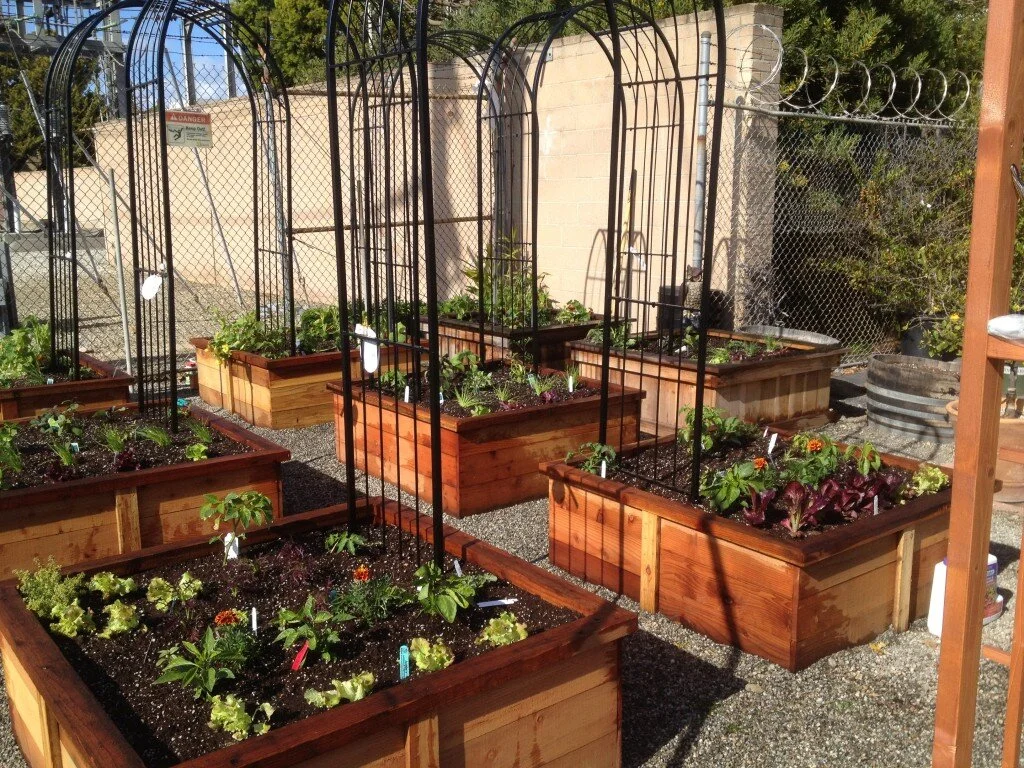Raised Expectations: How & Why to Build a Raised Bed
How do I build a raised bed?
This is such a common question that I decided to dedicate an installment of the Garden blog to this subject so that you can refer back to it as needed.
Let’s start with the “Why” of the question.
What are the benefits of growing in a raised bed?
ADVANTAGES OF RAISED BED GARDENING
Better drainage
Growing plants in raised beds is a logical choice for gardeners with heavy, poorly drained soils. Raised beds permit plant roots to develop in soil held above water-logged or compacted zones. This provides a more optimum soil environment for root growth. As beds are built up, compost or other forms of organic matter may be incorporated, further improving soil structure, drainage and nutrient-holding capacity.
Higher yields
Better root growth from improved soils leads to higher yields for food crops and lusher growth of ornamental plantings. Also, intensive planting in raised beds means more plants can be grown in a smaller area than with conventional row-cropping techniques. No space is wasted between rows.
Expanded growing season
Better drainage speeds soil warming and allows earlier spring planting. In wet seasons, soil dries out faster, permitting planting to proceed between rains.
Easier Maintenance
Because plants are growing above the level of foot paths, less stooping is required for weeding, watering and other chores. Intensively planted raised beds (the strategy I prefer) provide dense foliage cover, shading out much weed growth.
Using difficult sites
Raised beds make gardening possible on sites where growing plants would otherwise be impossible or very challenging. Rooftop gardens, gardens on slopes and raised beds on top of solid rock are examples.
Top photo of our commercial certified organic garden project on a Mailibu hillside. Bottom photo of raised beds we installed on top of a sunny slope in the rear of a Trusdale Estates residence.
A few words on the key elements
While I will let the links I’ve “harvested” from the web give you the specific instructions, I want to mention a few key elements that my years of building and using raised beds have proven to be essential ingredients for success.
1) ROOTING DEPTH = DEPTH OF RAISED BED: As important as this is to know when you’re planting into the ground, it’s even more important when you’re growing in raised beds and containers as well. My recommendation: IF YOUR NATIVE SOIL IMMEDIATELY BELOW your raised bed site is unworkable or otherwise impaired, make sure you build your beds deep enough to allow you to grow the widest range of veggies possible (at least 24 inches) AND establish and maintain a healthy soil food web. If your native soil is in good condition, is not contaminated and drains well, you can get away with building a shallower bed as your deeper rooting plants will be able to move down into the native soil as deeply as needed.
2) CONSIDER THE GARDENER: For ease of use and to make sure you don’t have to walk on your soil causing compaction, make the beds a width that allows all the gardeners tending the beds to access the middle of the beds comfortably…that usually means a width of about 4 feet total. You may have to make the bed narrower (3 feet wide) if the bed will not be accessible from all sides. Also consider the physical abilities of the main caretaker. Are they a younger or older gardener? Do they have a physical condition that may make it uncomfortable to bend or kneel? Are they in a wheelchair? All these issues should dictate the design of the raised bed in order to make the act of gardening as pain-free and enjoyable as possible for everyone.
3) MATERIALS: There are many options here. I’ve used redwood, cedar, broken concrete and cement ash block. All of these work well and, of course, if you re-purpose or reuse any of these materials – EVEN BETTER!
NOTE: DO NOT USE PRESSURE TREATED LUMBER. Even though there have been changes in the pressure treatment process, I still won’t use it and, therefore, can not recommend it to you. In certified organic production, growing in beds made with treated lumber is not allowed. Of course, this is up to the individual gardener to decide. Do your own research. I’m sure you’ll come to the same conclusion. After all, you’ve gone to all this trouble to keep your food source as pristine as possible, why risk chemicals leaching into your soil from your building materials? https://extension.oregonstate.edu/ask-expert/featured/raised-bed-lumber-pressure-treated-safe
Beds made of cedar or redwood (even unsealed) will last a good 5-10 yrs (depending on site/usage) which is a very acceptable life span. Of course as simple as these are to build some of you may be interested in buying kits. I’ve included a couple of links for you in the link list below.
Using raw linseed oil as a wood preserver is an acceptable way to extend the life of your boxes and is allowed in certified organic gardening.
Click on pictures to activate carousel
4) PEST CONTROL: Whatever materials you use to construct your beds, take care to add one important element to the bottom of your beds: heavy gauge hardware cloth or small opening, heavy gauge gopher wire (http://www.groworganic.com/gopher-wire-4-x-100-roll.html). Believe me, this extra step will save you much grief! This barrier method is the ONLY thing that stops gopher invasion in my client’s garden beds! It’s an easy addition to the bottom of the beds by stapling the panel of wire securely to the bottom of the raised bed leaving no gaps wide enough for these clever critters to find a way in. The wire will have to be replaced about every 5-6 yrs or so as those buggers will eventually work their way through as the barrier degrades. Keep in mind that adding this barrier will restrict root growth below the bed so compensate by making your beds deeper. Also, as you are designing your beds, consider adding a mechanism to support a hoop house around your bed. One of the “Garden Girl” videos below shows you how she does this. I’ve also seen pieces of pvc pipe attached to the outside of the beds so that a smaller diameter pvc pipe can be slipped into them easily to form the hoop structure. Use your imagination. Hoop houses are essential in pest protection and growing season extension.
That’s basically it! Enjoy the links below….post your questions AND, most importantly… post your photos of the raised beds you’ve built on The Cook’s Garden Venice Facebook fan page!
LINK LIST
Building a Raised Bed
(keep in mind that some of these videos may demonstrate a fairly shallow depth…remember you want deep beds 16-24″ which requires additional support if your native soil isn’t workable or viable)
KITS (keep in mind my recommendation on bed depth)
Art of the Garden – M Brace: Available on Amazon (Mbrace corner brackets featured in Martha Stewart Living March 2011 issue) How to build an MBrace raised bed from Art of the Garden on Vimeo. I love these! Such a simple concept yet it brings a high design look to simple raised beds. Made in the USA of steel which will patina over time but that just makes them even more beautiful!
Naturalyards.com Is a California family-owned company that was still making these kits out of their home when I first found them! Made of cedar, these kits are comprised of boards that fit together with steel pins. No screws, nails or tools needed!
I used these at a small oceanside cafe in Manhattan Beach back about a decade ago.
I hope you see how simple building these yourself really is. All you need is a drill, screws and a trip to your favorite lumber store. They’ll even cut the boards for you! Remember…no need to spend extra money on heartwood redwood. The common grade is A-OK! Or you can opt for one of the kit systems and be TOOL-LESS! So have fun and don’t forget to post your handiwork on The Cook’s Garden Venice Facebook fan page!













